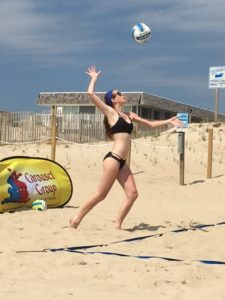
Mom is 5’11” and dad is 6’8″, they are two great athletes who met playing basketball at St. Anselm in New Hampshire. So it’s no wonder their kids are tall and athletic, but it is unique that neither one chose to follow in their parents’ footsteps. Bobby (6’9″) plays indoor volleyball at Penn State and his little sister, Sammi (5’10”) just verbally committed to play beach volleyball at Stetson University in Florida. Neither focused on their #1 sport until 10th grade. Here is the story of how this basketball family switched gears and fell in love with volleyball as told by their mom, Janine.
1. What age did your kids start playing sports and what sports? Our family is really sports oriented, so as soon as they could run and understand basic instructions, they were on a team – I think pee wee soccer was first when they were about 4 and they played basketball in their elementary school. Bobby played T-ball and flag football from 5th – 8th grade. Club basketball for each of them started around the 4th grade. Bobby focused on basketball from 4th grade through 10th grade. He was introduced to volleyball in the 8th grade through friends from school. He went reluctantly to a volleyball tryout. Volleyball isn’t big in northern VA, so it was hard to get a team together. He went to the tryout just to check it out, and has loved it ever since. 

2. Did you coach your kids and if so how much and in what? We both coached our kids in basketball from rec age through 8th grade AAUs (for Sammi) and through 9th grade AAUs for Bobby.
3. Approximately how many hours per week do they spend doing their sport? Sammi does strength training 3 times a week (1.5 hours each time) and practice 3 times a week (2 hours each time). Then tournaments are usually at least a day and a half on the weekends. So, during peak season, she spends about 24 hours a week. That doesn’t include any travel time to tournaments that are not local. Prior to college, Bobby spent at least 20-25 hours a week on volleyball alone. Although practices were only a commitment of 6 hours a week, he was a gym rat, trying to get space whenever he could to work on something, whether it was serving (if he couldn’t find a buddy to go with him) or hitting, or footwork. At PSU, when he was healthy, Bobby spent an average of about 4 hours per day/28 hours per week between lifting, practice, and games. Now that he is recovering from an injury, he has PT twice a day, which adds 2.5 hours every day.
4. What are their goals for their sport and how have they changed? For Sammi, she wants to play beach volleyball at a top 25 program where it’s warm year-round. She recently verbally committed to Stetson University in Deland, FL, which met her criteria! She feels very fortunate and is looking forward to becoming part of the Stetson beach program. Growing up, Bobby wanted to play basketball at the collegiate level, until he discovered indoor volleyball. In high school, the seasons conflicted. He had an awesome coach for volleyball in the 9th grade who was very accommodating when there were conflicts. But Bobby hated missing volleyball more than he loved playing basketball. He decided at 10th grade to focus exclusively on volleyball. Once he focused on volleyball, his goal was to play college volleyball at PSU.
5. How do you help them achieve their goals? We try to be supportive by giving our time (which is easy – we love going to all the events and watching them play) and we’ve been lucky enough to support their passions financially. We’ve always been willing to help them do the extra thing to give them a step up, whether that means supplementing their strength and conditioning or extra skills lessons/clinics with instructors. A lot of time was also spent editing game footage and putting together highlight videos to send to coaches. We’d also like to think we support them in non-tangible ways, too. We think they both would tell you that we were behind them, as hard as it was for us to see them give up basketball. They both were really good at basketball, and Mike and I naturally had a passion for it as we played through college. We do our best never to miss an event – which is impossible to accomplish “physically,” but because of streaming video, most of the time while one of us is at one event, the other is streaming from the other event.
6. What has been the most difficult or challenging aspect to their sports? Despite all of the preparation and support we give to help them achieve their goals, sometimes the road isn’t as easy as we think it should be. With sports comes injury, which when you have competitive kids who hate sitting on the sidelines, dealing with adversity has posed the greatest challenge for us as parents. Teaching them that despite all the preparation and dedication you have given to your sport over the years, you’re told you can’t play for several months. Bobby is going through a rough time now as he just had a pretty invasive surgery which requires significant time to heal and regain strength. It’s tough to find the right words to get him through, because our words don’t help in any tangible way to get him better and back to playing. We just want him to always knows we are empathetic toward what he’s going through and that all of this will be behind him some day and he will be back to playing the sport that he loves. Despite this phase of difficulty, we want him to hold on to the hope that this phase of adversity in his career can only make him stronger and appreciate the good times…not to take anything for granted. And that all of this will make his story great someday.
7. They both waited until 10th grade to completely focus on their chosen sports. Was this helpful or hurtful to their success? Helped for sure. I don’t know if it was the “newness” of the sport or the fact that they probably burned out from hoops (which was their primary sport before deciding to focus on vball ) because Mike and I might have wanted it too much for them. Maybe we pushed them too much in basketball. Mike and I didn’t know anything about volleyball, so we really couldn’t “give them pointers” (e.g. Criticize them) like we did in basketball. We were always ready to “help them” after hoops games; but with volleyball, we just watched them play. I’m sure it wasn’t the only factor, but I’m sure it was one that contributed to their burnout in basketball.With volleyball, I can’t say I’ve seen any sign of burnout yet from either of them. There’s a volleyball on every floor in the house and when they’re home, they are on the floor passing to themselves. Bobby makes extra time for volleyball….he would do what he was supposed to in basketball (practice, conditioning, etc.) but with volleyball, he does what he’s supposed to do but deliberately makes time in his day to work on his own because he wants to, not because he has to.
8. What are some of your secret weapons or unique ways you have found to help the kids either excel or stay balanced? Aside from maintaining priorities, we try to teach our children that no matter what you do in life, whether it’s taking a course, writing a college entrance essay, working toward a degree, practicing your sport – do the best you can. With success comes freedom. The better you do at something, the more options you will have in choosing your path in life. If you did great in high school, you will have more options for college; if you did well in college, you will have more options in finding a job; if you pushed yourself in practice, you will get more playing time. No matter what you do, do your honest best at it – you will have freedom via opportunity and you will have no regrets looking back, knowing that you always put your best foot forward.
9. What drives you most crazy about youth sports and what do you do to help make it better? It seems that children are pressured to pick “their sport” at a younger and younger age. Sports now are “year-round” vs. seasonal, which doesn’t afford kids the opportunity to really see what they are good at or what interests them. And both (what you’re good at and what interests you) change as you grow and develop. It is a shame that kids feel this pressure from their peers, coaches, and sometimes even parents to focus exclusively on a single sport at a young age. We encouraged our kids to play multiple sports until they made the decision on their own to specialize. For both of them, that was in the 10th grade, and that seems pretty late in today’s youth competitive sports environment.
10. What is your ultimate dream or desire for them and/or your family in regards to their sports? That participating in their sport makes them truly happy and that they are healthy to play as long as they desire to. That they learn the valuable life lessons of what it means to be a good teammate – that skill will take them far in life, beyond sports, but also in marriage, in their professional adult careers (whatever path that may be), and in their lifelong friendships.















